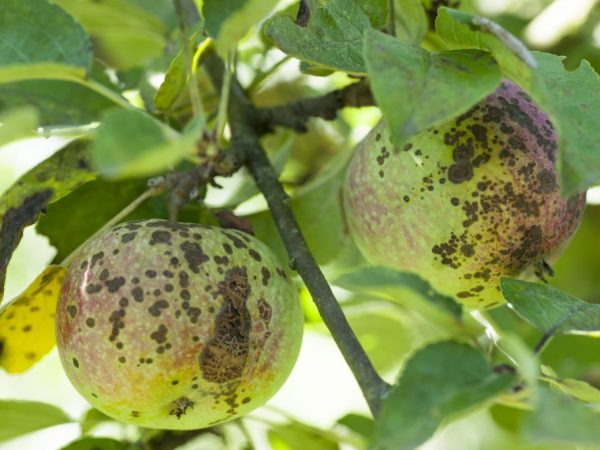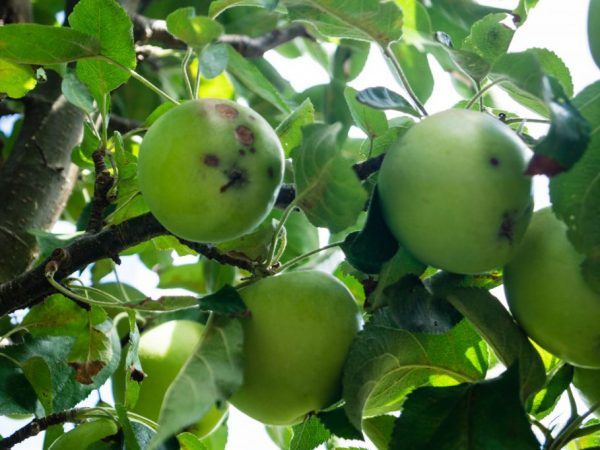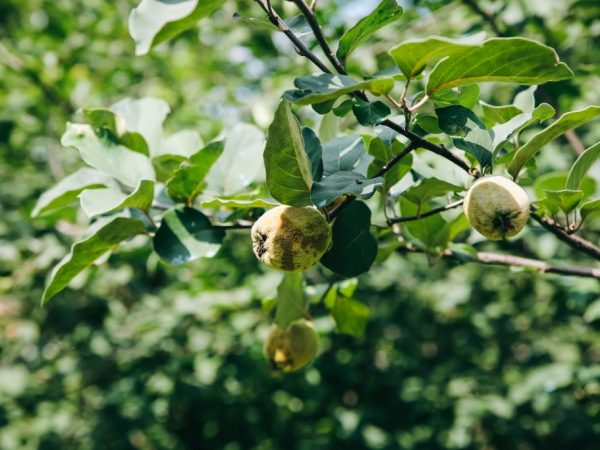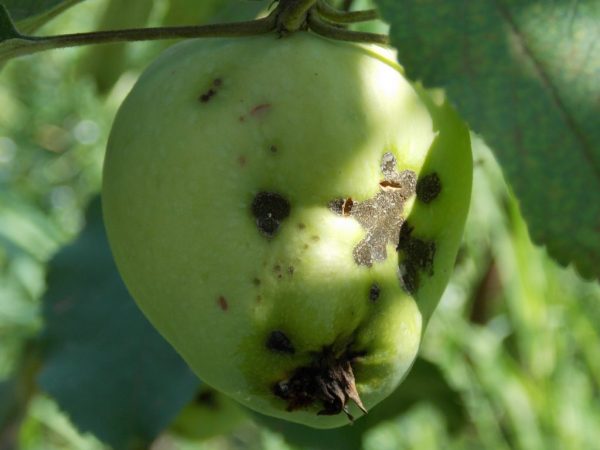Scab control on an apple tree
The scab that appears on the apple tree is the reason for the shrinking of the fruits and the reduction in the apple harvest. Under the influence of the disease, apples lose their taste, deform and lose keeping quality during storage after harvest.

Scab control on an apple tree
Etiology of the disease
The causative agent of apple scab and the source of the associated damage to leaves and fruits is the marsupial fungus.
It retains its vitality during the winter period, remaining inside unripe fruit bodies - pseudothecia, formed in autumn on fallen leaves and apples, in cracks in tree bark and on dry dead branches.
With the active growth of apple shoots, the fungus begins to disperse spores, which are attached to the leaves by means of the mucous membrane.
Infection process
At risk are young seedlings, in which the upper layer of young leaves is affected.
At the initial stage, scab fungal spores settle in the space between the leaf skin and the cuticle, without penetrating into the deep tissue cells. After 2-3 weeks, the conidial stage of development begins, in which, through the spread of conidia, the previously affected foliage of the apple crown becomes infected again.
Inflorescences, shoots and ovaries also fall under the destructive effect.
When the foliage falls, the scab continues its development in the form of a saprotroph, destroying the dead remains. At this stage, the fungus lays pseudothecia, which, when warm, is activated, starting a new development cycle.
Scab harm
The infection does not carry a detrimental effect on garden culture, does not stop the processes of photosynthesis, while preserving the ability of trees to develop and bear fruit.
However, it is harmful to the crop, because significantly reduces its quantity and degrades the quality characteristics of the fruit, so the tree must be treated.
If the fruits are affected, then:
- they become smaller in size, deform, become ugly, acquiring an unattractive presentation;
- the amount of vitamins contained is reduced;
- gastronomic characteristics deteriorate - they acquire an unpleasant aftertaste;
- early fall of foliage;
- most of the fruit falls off in a timely manner.
Causes and symptoms

High humidity contributes to the spread of the disease
For the active spread of scab, moisture and heat are required, therefore the disease is widespread in climatic zones with warm weather conditions - especially in regions where cold and wet springs are observed.
A favorable factor for the appearance and active development of the fungus is an increase in the ambient temperature to 20 ° C and above, as well as prolonged rains.
Among other reasons, there is a violation of the basic rules of agricultural technology when growing:
- planting varieties with the same genotype at a minimum distance from each other;
- irregular pruning and formation of the apple crown for normal circulation of air flows;
Symptoms
In the process of infesting an apple tree with scab, the foliage is covered with spots of a light olive color.
Over time, the lesions grow in diameter, acquire a brown tint and crack, opening the way for other viral, bacterial and fungal infections to enter.
Shoots, fruit cuttings and apples are covered with a rash that looks like a cluster of small dry spots and specks.
Chemical and folk remedies
The fight against scab on an apple tree is carried out by treatment with chemicals. When using them, the timing of the treatments is planned depending on the growing stage.
Alternative to pesticides are folk remedies. They do not have a toxic effect on and do not contain components harmful to humans.
Chemical treatments
With the massive appearance of the primary signs of the fungus, the garden culture is treated with pesticides:
- urea (urea) with a concentration of 10%: 100 g per 10 liters of water;
- ammonium nitrate with a concentration of 10%: 100 g per 10 liters of water;
- potassium chloride with a concentration of 7%: 70 g per 10 liters of water.
You can process apple trees with any of the preparations no more than 2 times per season with an interval of 10 days.
Restrictions on treatment: do not use urea, saltpeter and potassium at the stage of bud opening, during budding, fruiting and harvesting.

Processing is prohibited at the harvest stage
With the active spread of scab, in order to preserve the quantity and quality of the future harvest, they resort to treating the apple tree with fungicidal substances of 3-4 class of danger:
- Horus - recommended for the protection of young seedlings, is used at an ambient temperature of 3 ° C, its effectiveness decreases when the temperature exceeds 25 ° C;
- Gamair - the drug can be used with an intermediate interval of 7-10 days;
- Fitolavin is a fast-acting composition that penetrates into the deep layers of tissues, is resistant, therefore it is recommended for single use;
- Strobi - resistant to moisture, does not lose its effectiveness when temperatures change, restrictions - up to 3 times during the growing season;
- Speed - retains activity for a long period, to increase the effectiveness of treatment, it is recommended to re-process it after 14 days;
- Raek is an analogue of the Skor complex, capable of quickly, in 2-2.5 hours, penetrating into the deep layers of tissues, and is resistant to moisture.
Folk remedies
You can also fight scab on apple trees with the help of folk remedies.
They are not dangerous for horticultural culture, therefore they are used regularly, incl. at the fruiting stage:
- fertilizing complex of the biological spectrum of action Baikal-EM1, they should spray the soil along the near-trunk circle, additionally mulching it with sawdust;
- a concentrated solution of potassium permanganate, its use is permissible for disinfecting tree bark and soil, in order to process foliage, use a weak solution of potassium permanganate to avoid getting it burns;
- saline solution - 0.5 kg per 10 liters, treatment is planned for a time after leaf fall.
Preventive measures
Preventive measures against fungal infections can help prevent fungal infections. To this end:
- planning a sparse planting of apple trees, maintaining the recommended distance between them from 2-3 m or more, the average interval between plantings of dwarf and low-growing varieties - from 2.5 m, for vigorous varieties - 5-6 m;
- destroy possible places of accumulation of fungal spores and other infections, carefully removing fallen leaves during autumn care;
- in the fall, deep digging of the soil is carried out, provided that there are no signs of the disease in the current fruit and berry season, in case of infection of apple trees with infection, the soil is loosened to a shallow depth and treated with fungicides before wintering in the area of the trunk circles;
- throughout the growing season, foliar dressing is carried out and apple trees are sprayed with mineral compositions;
- in the fall, broken and diseased branches are cut off, the exfoliated tree bark is cleaned and the lichens and mosses that have settled on it are removed;
- in the spring, whitewash the trunks 2 m in height, skeletal branches and cuts.
Resistant varietal varieties
The description of the prevention of fungal disease also includes the selection of scab-resistant apple varieties.
Resistance is controlled by 15 different genetic units, which are taken as a basis by breeders and genetic engineering when breeding new species.

Processing can help avoid contamination
Among the immune varieties showing the least resistance to infection are Melba and Golden Chinese. Relatively resistant:
- Orlinka, Yablochny Spas and Medunitsa for the Moscow Region;
- Slav, Suvorovets and Druzhba for the northwest of Russia;
- Spartan, Beforest and Veteran for the Urals;
- Carmen, Lyubava and Argo for Siberia.
The degree of protection depends on the regional characteristics of the area where the garden culture is grown.
Preventive treatments
To prevent the appearance of scab at the beginning (spring) and at the end (autumn) of the growing season, you can also treat the apple tree.
Wherein:
- the use of chemical complexes containing fungicides and pesticides is planned for a time after leaf fall, but until the ambient temperature drops below 5 ° С, because a low temperature regime reduces the effectiveness of the action of active substances;
- treatments are carried out in dry weather, if rain occurs after spraying, the preventive procedure is repeated;
- the entire garden is subject to spraying, the trunk, skeletal branches, shoots are treated on the trees, paying special attention to cracks on the surface of the tree bark and where the buds grow;
- additionally sprayed soil.
To prevent the appearance of fungus in the spring, the soil is watered with the Baikal-EM1 fertilizer complex. It accelerates the decay processes of the foliage left over from the fall and improves the composition of the soil.
Folk remedies
Folk preventive remedies to help create protection in the spring:
- Mustard. The best time to start procedures with mustard-based solutions is the second half - the end of May. Cooking method - 4 tbsp. mustard powder per 10 liters of water, To secure an effective result, spraying mustard trees on apple trees is repeated after 2 weeks.
- Horsetail. The herbal infusion is prepared from fresh grass (a quarter of the bucket is filled with horsetail, 10 liters of hot water are poured in and kept for 72 hours), filtered and the volume is increased with water to 10 liters. Frequency of application - regularly with an interval of 14-21 days.
Chemicals
The following drugs help protect apple trees from scab in the fall:
- Nitrafen - 100 grams per 10 liters of water;
- Bordeaux liquid with a concentration of 3% - 300 grams of copper sulfate and 400 grams of limestone per 10 liters of water.
Pesticides are not sprayed at the stages of budding, during flowering and fruiting, replacing these measures with folk remedies.
Conclusion
Scab significantly lowers the qualitative and quantitative characteristics of apple crops.
It appears mainly in regions with warm and humid climates. It is more often associated with violations of the rules of agricultural technology (thickening of plantings, improper care, etc.). It is treated with chemical and folk remedies.
The best measure to combat the fungus is the prevention and planting of infection-resistant varieties adapted to the cultivation region.

